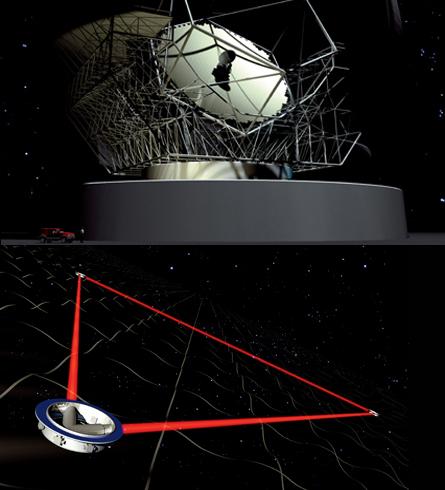The next generation of telescopes will reveal the mysteries of the universe to us

TMT - 30 meter long telescope
In the previous edition we examined the James Webb Space Telescope. This week we will focus on a telescope with a giant mirror that has 18 hexagons, eight telescopes working as one and riding the waves of time.
A 30 meter long telescope - a giant examining the birth of the universe
Sponsor: Union of Research Universities.
Location: On Earth, the exact location has not yet been determined.
Cost: $700,000,000 (estimated)
Estimated completion: 2014
The huge telescope, located on the ground, is free from the constraints of rockets and space travel. It will include a main mirror 30 meters long, with 18 hexagons. The consortium of research universities planning the TMT will fill it with light – more light than astronomers have ever collected in a single mirror. This telescope will have a greater light gathering capacity than the ten largest existing telescopes in the world today. The planners hope to build it in the time frame of the James Webb Space Telescope, that is, in about a decade. The success of the project is important because the space telescopes and the ground telescopes complement each other.
In the darkness of space, where the contrast between the black void and the starlight is greatest, a telescope like James Webb's will be able to detect very faint objects that no one has been able to see before. After James Webb locates one of these objects, TMT will direct its giant eye for several hours and produce a sharper image and probe to see what the object is made of. The TMT should reveal how the stars formed heavier elements, such as coal and iron, in their nuclear fusion cores. Astronomers will use a process called spectroscopy to track the creation of these elements as the universe ages. TMT will separate light from the earliest stars into different wavelengths. Elements within these stars will absorb light at certain frequencies. This means that by tracking the weakest frequencies in the star's spectrum, astronomers will be able to reveal the elements that make up the stars and the amount of each element that the star contains.
TMT's large diameter should earn it the title of the sharpest telescope in the world. It will produce clear images, showing the individual stars in the ancient galaxies, which James Webb will discover, as an indistinct blur. Like James Webb, TMT will also be very flexible and will be designed for all types of astronomical uses. Due to its huge dimensions, it has a good chance of being the first telescope in the world to produce an image of a planet around another star.
First the monster must be built, and therein lies an incredibly mundane challenge. The problem is not technological but logistical and budgetary. The TMT group knows how to build the telescope, but it does not have a huge body like NASA behind it. The Union of Research Universities relies on the National Science Foundation, private foundations and the kindness of foreign parties. A significant part of the TMT design challenge is simply to cheapen the project. The mirror segments, for example, are similar to the 36 hexagons that make up the Kak telescopes which were built by decade, but the amount in the TMT may reach 1,000. It is not possible to create any such segment by hand, therefore the basic technology for creating mirrors must be upgraded so that such mirrors will be produced in the same way as cheap cars are produced. Performing this process automatically will lay the cornerstone for the construction of much larger telescopes in the future. The solutions provided by TMT will also fit a 100 meter diameter telescope.
Another challenge: once they are ready to build the largest telescope ever built, where exactly are they going to place it? There are several potential sites in Mexico, Hawaii and Chile. The chosen place must successfully pass several tests. For example, it must be far enough away that light coming from nearby populated areas does not interfere with its operation. It must be dry, because water vapor causes distortion in the atmosphere. Priority is given to places where the wind speed is low, because such a huge structure will shake like a skyscraper in the wind and blur the pictures. And of course, a place where there won't be too many cloudy nights.
Interferometer (interferometer) - eight telescopes working as one
A telescope's ability to distinguish the smallest details is based on the width of the instrument from one end to the other. This fact leads to a trick: if you combine the light coming from several separate telescopes so that they act as one, you can achieve much better resolution. This is the idea behind VLTI, a network that includes four 8.2 meter wide telescopes and four 1.8 meter wide telescopes located in Chile. The combined light from all of them will produce images as sharp as those of a single 100 meter telescope.
Estimated completion: 2005
www.eso.org
Space antenna for laser interferometry - riding the space-time waves
The LISA program is probably one of the boldest programs on this list. Three satellites that will fly in a formation around the sun, at a distance of 4,800,000 km, will measure with the help of lasers the distance between them to an accuracy of half a billionth of an inch. If it works, the satellites will detect the stretching of spacetime between them, tracking the ripples caused by nearby stars or collapsing black holes in distant galaxies.
Estimated completion: 2012.
